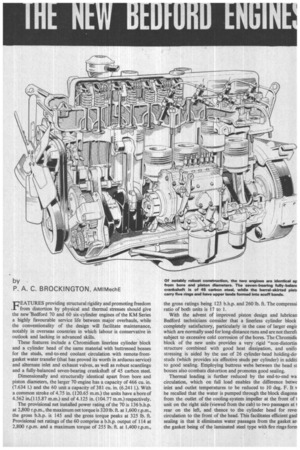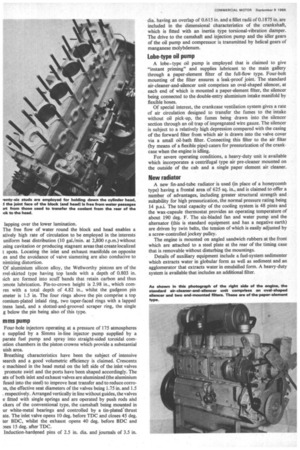by
Page 59

Page 60

If you've noticed an error in this article please click here to report it so we can fix it.
P. A. C. BROCKINGTON, ANI1MechE
ElEATURES providing structural rigidity and promoting freedom from distortion by physical and thermal stresses should give the new Bedford 70 and 60 six-cylinder engines of the KM Series a highly favourable service life between major overhauls, while the conventionality of the design will facilitate maintenance, notably in overseas countries in which labour is conservative in outlook and lacking in advanced skills.
These features include a Chromidium linerless cylinder block and a cylinder head of the same material with buttressed bosses for the studs, end-to-end coolant circulation with remote-fromgasket water transfer (that has proved its worth in arduous service) and alternate inlet and exhaust valves, as well as robust scantlings and a fully-balanced seven-bearing crankshaft of 45 carbon steel.
Dimensionally and structurally identical apart from bore and piston diameters, the larger 70 engine has a capacity of 466 cu. in. (7.634 1.) and the 60 unit a capacity of 381 cu. in. (6.241 I.). With a common stroke of 4.75 in. (120.65 m.m.) the units have a bore of 4.562 in.(115.87 m.m.) and of 4.125 in. (104.77 m.m.) respectively.
The provisional net installed power rating of the 70 is 136 b.h.p. at 2,800 r.pan., the maximum net torque is 320 lb. rt. at 1,600 r.p.m., the gross b.h.p. is 145 and the gross torque peaks at 325 lb. ft. Provisional net ratings of the 60 comprise a b.h.p. output of 114 at 2,800 r.p.m. and a maximum torque of 255 lb. ft. at 1,400 r.p.m., the gross ratings being 123 b.h.p. and 260 lb. ft. The compressi ratio of both units is 17 to 1.
With the advent of improved piston design and lubrican Bedford technicians consider that a linerless cylinder block completely satisfactory, particularly in the case of larger engir which are normally used for long-distance runs and are not there& subject to excessive cold corrosion of the bores. The Chromidit block of the new units provides a very rigid "non-distortin structure combined with good heat dissipation, and unifo stressing is aided by the use of 26 cylinder-head holding-do. studs (which provides six effective studs per cylinder) in additi to good sealing. Employing buttress webs between the head st bosses also combats distortion and promotes good sealing.
Thermal loading is further reduced by the end-to-end wa circulation, which on full load enables the difference betwe inlet and outlet temperatures to be reduced to 10 deg. F. It v be recalled that the water is pumped through the block diagona from the outlet of the cooling-system impeller at the front of 1 unit on the right side (viewed from the cab) to two passages at I rear on the left, and thence to the cylinder head for revel circulation to the front of the head. This facilitates efficient gas] sealing in that it eliminates water passages from the gasket an the gasket being of the laminated steel type with fire rings form lapping over the lower lamination.
The free flow of water round the block and head enables a atively high rate of circulation to be employed in the interests uniform heat distribution (10 gal./min. at 2,800 r.p.m.) without Bing cavitation or producing stagnant areas that create localized t spots. Locating the inlet and exhaust manifolds on opposite es and the avoidance of valve siamezing are also conducive to nimizing distortion.
Of aluminium silicon alloy, the Wellworthy pistons are of the rrel-skirted type having top lands with a depth of 0.803 in. iich are formed into scuff bands that retain carbon and thus 3mote lubrication. Pin-to-crown height is 2.98 in., which coinres with a total depth of 4.82 in., whilst the gudgeon pin meter is 1.5 in. The four rings above the pin comprise a top romium-plated inlaid ring, two taper-faced rings with a lapped tness land, and a slotted-and-grooved scraper ring, the single g below the pin being also of this type.
Mms pump
Four-hole injectors operating at a pressure of 175 atmospheres e supplied by a Simms in-line injector pump supplied by a prate fuel pump and spray into straight-sided toroidal comtalon chambers in the piston crowns which provide a substantial uish area.
Breathing characteristics have been the subject of intensive search and a good volumetric efficiency is claimed. Crescents e machined in the head metal on the left side of the inlet valves promote swirl and the ports have been shaped accordingly. The ats of both inlet and exhaust valves are aluminized (the aluminium fused into the steel) to improve heat transfer and to reduce corrom, the effective seat diameters of the valves being 1.75 in. and 1.5 respectively. Arranged vertically in line without guides, the valves e fitted with single springs and are operated by push rods and ckers of the conventional type, the camshaft being mounted in ur white-metal bearings and controlled by a tin-plated.thrust ate. The inlet valve opens 10 deg. before TDC and closes 45 deg. ter BDC, whilst the exhaust opens 40 deg. before BDC and Dses 15 deg. after TDC.
Induction-hardened pins of 2.5 in. dia. and journals of 3.5 in. dia. having an overlap of 0.615 in. and a fillet radii of 0.1875 in. are included in the dimensional characteristics of the crankshaft, which is fitted with an inertia type torsional-vibration damper. The drive to the camshaft and injection pump and the idler gears of the oil pump and compressor is transmitted by helical gears of manganese molybdenum.
Lobe-type oil pump A lobe-type oil pump is employed that is claimed to give "instant priming" and supplies lubricant to the main gallery through a paper-element filter of the full-flow type. Four-bolt mounting of the filter ensures a leak-proof joint. The standard air-cleaner-and-silencer unit comprises an oval-shaped silencer, at each end of which is mounted a paper-element filter, the silencer being connected to the double-entry aluminium intake manifold by flexible hoses.
Of special interest, the crankcase ventilation system gives a rate of air circulation designed to transfer the fumes to the intake without oil pick-up, the fumes being drawn into the silencer section through an oil trap of impregnated wire gauze. The silencer is subject to a relatively high depression compared with the casing of the forward filter from which air is drawn into the valve cover via a small oil-bath ffiter. Connecting this filter to the air filter (by means of a flexible pipe) caters for pressurization of the crankcase when the engine is idling.
For severe operating conditions, a heavy-duty unit is available which incorporates a centrifugal type air pre-cleaner mounted on the outside of the cab and a single paper element air cleaner.
New radiator A new fin-and-tube radiator is used (in place of a honeycomb type) having a frontal area of 625 sq. in., and is claimed to offer a number of advantages, including greater structural strength and suitability for high pressurization, the normal pressure rating being 14 p.s.i. The total capacity of the cooling system is 48 pints and the wax-capsule thermostat provides an operating temperature of about 190 deg. F. The six-bladed fan and water pump and the alternator (this is standard equipment and has a negative earth) are driven by twin belts, the tension of which is easily adjusted by a screw-controlled jockey pulley.
The engine is mounted on angled sandwich rubbers at the front which are attached to a steel plate at the rear of the timing case that is removable without disturbing the mountings.
Details of auxiliary equipment include a fuel-system sedimenter which extracts water in globular form as well as sediment and an agglomerator that extracts water in emulsified form. A heavy-duty system is available that includes an additional filter.
































































































































